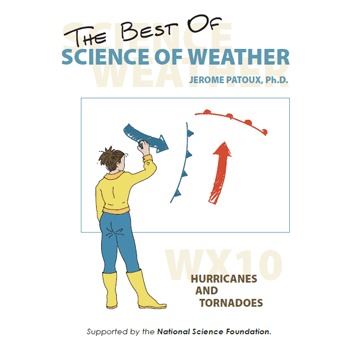Science of Weather - WX10: Hurricanes and Tornadoes
Jerome Patoux
138 Followers
Grade Levels
5th - 12th, Adult Education, Homeschool
Subjects
Resource Type
Formats Included
- PDF
Pages
76 pages
Jerome Patoux
138 Followers
Description
This series is the tenth and last of the Science of Weather digital extensions, a digital version of the original Science of Weather curriculum, also available in print. While the original paper version was published as one single volume of worksheets, and separate teaching notes in 5 volumes, these new series contain both the worksheets and the teaching notes, and are broken down by themes, to accommodate teachers who might be interested in teaching a particular topic, rather than a full blown, year-long, weather and climate curriculum. (If, however, you are only interested in the worksheets, consider downloading the student workbook. If you are interested in the entire set of teaching notes, consider downloading the "5-volume set.")
WX10 Hurricanes and Tornadoes concludes Science of Weather by bringing all concepts together to investigate hurricanes/typhoons and read about tornadoes. Students will learn about the following:
- The life story of a hurricane, using Hurricane Ivan as an example.
- Hurricane central pressure, maximum wind speed, and track.
- The role of ocean temperature and trade winds in the formation and evolution of hurricanes.
- The Saffir-Simpson scale.
- The structure of hurricanes (eye, eyewall, convective clouds and cirrus clouds, thunderstorms) and the positive feedback loop fueling hurricanes.
- Landfall.
- The differences between hurricanes and midlatitude cyclones.
A last reading exercise presents basic facts about tornadoes while explaining why "tornado alley" provides the ideal setting for tornado formation.
Students also learn to think, explain, and write in logical format, showing cause-and-effect relationships. They apply specific math concepts (graphing, axes, x- and y-increments, minima and maxima) and practice proportional reasoning.
While the earlier Science of Weather activities can be adapted for grades 2 to 5, this is better suited for middle and high school. I also use these worksheets as starting points and activities in my professional development workshops. This particular series is a good complement/supplement to existing weather, climate, and environmental science modules, such as STC Catastrophic Events (Understanding Weather and Climate) and It's About Time EarthComm.
All the activities are aligned with the national standards, as made explicit at the end of each activity in these Teaching Notes.
For more information, visit www.scienceofweather.org
Science of Weather is licensed under a Creative Commons Attribution-NonCommercial-NoDerivs 3.0 Unported License.
WX10 Hurricanes and Tornadoes concludes Science of Weather by bringing all concepts together to investigate hurricanes/typhoons and read about tornadoes. Students will learn about the following:
- The life story of a hurricane, using Hurricane Ivan as an example.
- Hurricane central pressure, maximum wind speed, and track.
- The role of ocean temperature and trade winds in the formation and evolution of hurricanes.
- The Saffir-Simpson scale.
- The structure of hurricanes (eye, eyewall, convective clouds and cirrus clouds, thunderstorms) and the positive feedback loop fueling hurricanes.
- Landfall.
- The differences between hurricanes and midlatitude cyclones.
A last reading exercise presents basic facts about tornadoes while explaining why "tornado alley" provides the ideal setting for tornado formation.
Students also learn to think, explain, and write in logical format, showing cause-and-effect relationships. They apply specific math concepts (graphing, axes, x- and y-increments, minima and maxima) and practice proportional reasoning.
While the earlier Science of Weather activities can be adapted for grades 2 to 5, this is better suited for middle and high school. I also use these worksheets as starting points and activities in my professional development workshops. This particular series is a good complement/supplement to existing weather, climate, and environmental science modules, such as STC Catastrophic Events (Understanding Weather and Climate) and It's About Time EarthComm.
All the activities are aligned with the national standards, as made explicit at the end of each activity in these Teaching Notes.
For more information, visit www.scienceofweather.org
Science of Weather is licensed under a Creative Commons Attribution-NonCommercial-NoDerivs 3.0 Unported License.
Total Pages
76 pages
Answer Key
N/A
Teaching Duration
N/A
Report this resource to TPT
Reported resources will be reviewed by our team. Report this resource to let us know if this resource violates TPT’s content guidelines.





